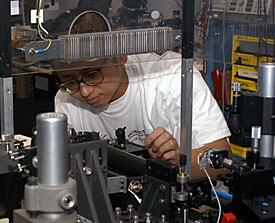 |
|
MALLORY LORING/Arizona Daily Wildcat
|
Optical science graduate student Yan Zhang looks over a dynamic test stand used for volumetric data storage. Zhang is one of the grad students that could lose funding if the UA continues to have problems with money.
|
|
|
By Debra Hollander
Arizona Daily Wildcat
Wednesday September 17, 2003
Last year research assistants celebrated the university's decision to charge graduate assistants for only half of their tuition.
However, because they pay less now, costs are rising for their departments, who are wondering how they will foot the bill.
Tuition remission ÷ a reduction in the amount gradate assistants pay to attend classes ÷ is unlike a waiver in that it must be paid for by another source.
"It raises the overall cost of research, if we have $100,000 (in a research grant), and money is going to tuition remission, something has got to give," said Gary Esham, associate director for finance and administration in Optical Sciences.
In addition to having to find funds to pay for tuition remission, departments are also dealing with rising health care costs.
Last year the Employee Related Expense, or the cost of employee benefits, was at 3.2 percent of a research assistant's wages. This year the cost is at 14.5 percent because there has been a 2.5 percent rise in health care costs and departments have to put 8.8 percent of the wages toward tuition remission.
While the remission for teachers' assistants is covered by state funds, research assistants are usually covered by the grants for which they do research.
In order to help out departments this year, the UA has offered close to half a million dollars in aid.
"The jump (in ERE) can be significant to existing grants. That's why we have offered to offset that jump," said Dorian Voorhees, assistant dean of the graduate college. "We don't plan to compromise any grant or any graduate student being hired."
This is the first year remission has covered research assistants; in the past only TAs were eligible for the remission. Last year, the remission for TAs was 25 percent.
"We want to keep RAs and TAs on an equal level," said Voorhees.
Esham, whose department asked for $289,079 to cover the remission this year, said the effect of the remission would have been particularly bad if administration hadn't stepped in because faculty did not have the extra cost figured into their grant budgets.
Voorhees said 730 e-mails were sent out last February to researchers who received grants after the remission was announced, but there were only 95 replies asking for aid.
Fifty-one of the 95 replies were from Optical Sciences, Voorhees said.
She said she feels this is a good indication that most departments are capable of covering the increase.
However, some departments are still worried.
Esham said that although the problem has been remedied for this year, he is concerned about grants within the Optical Sciences Department that will roll over into next year. It is not yet known if the university will help cover remission costs next year.
Esham is also concerned about the grants that his department will apply for in the future.
"Some grants are fixed amounts, some aren't. This affects those that are set," he said, explaining that if the grants aren't fixed amounts the faculty can apply for more money during the initial grant application to cover the extra cost of research assistant benefits and tuition remission.
"Will the remission alone price you out of the market (when applying for grants)? Probably not, but with everything going up it could," he said.
Esham said the extra cost could eventually cause the number of graduate assistants hired within his department to go down, but he said it is too soon to really pinpoint the effects of the remission.
Norma Maynard, manager for administration and finance in the Anthropology Department, said she was also concerned about the increase in tuition remission's affect on her department, which asked for $27,070.
"The increase in ERE is a hardship, but the department will do everything it can not to let it impact our students," she said.
Maynard said she was mostly concerned about how departments would cover the remission this year. She said she feels in the future the extra costs will be able to be worked into new grants without causing excessive hardship.
"The most important thing is that they (the RAs) are getting benefits. It's more important than having to pay extra percentages," she said.
Maynard said it is too soon to tell what the effect of the extra cost will be on hiring practices and research within her department.
Another issue surrounding the use of grant money to cover remission is that more of the money is coming from departments that pay their RAs higher.
"I think departments right now are affected disproportionately. There are some equity issues across departments," said Veronica Diaz, external vice president of the Graduate and Professional Student Council.
When departments pay for research assistant remission, the money they pay goes into a pot that is used to cover the entire research assistant population at the UA.
Departments that pay their research assistants more pay a greater amount into the pot for remission because every department pays 8.8 percent of their research assistant's wages, Esham said.
Optical Sciences, for example, pays over $2,600 for each research assistant on average, while Language, Reading and Culture pay about $1,700 per master's student, or $2,000 per doctoral student.
"They (the higher paying departments) are not real excited that they are contributing to a pot, not just their own students," Esham said.
